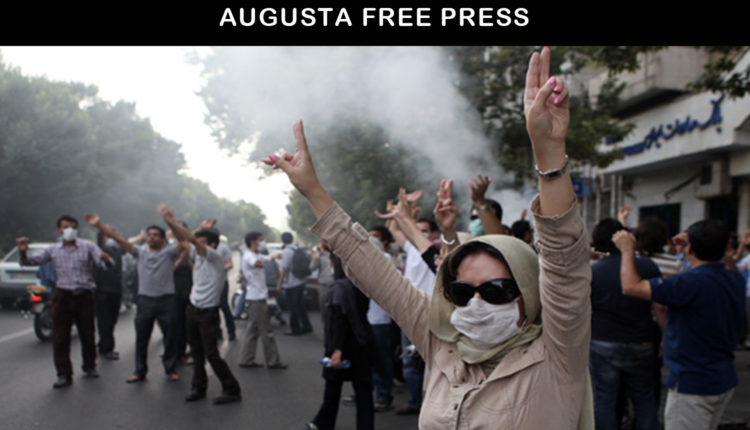Iran’s people are key to the success of new U.S. strategy to deal with Tehran’s threats

11-2-2017
HOMEIRA HESAMI
AUGUSTA FREE PRESS – When the nuclear deal between Iran and the P5+1 world powers was engineered by the Obama administration in 2015, the globe was cloaked in a false security blanket. Last June, unsurprisingly, the National Council of Resistance of Iran (NCRI) in Washington, DC revealed disturbingly current details concerning the Islamic Revolutionary Guards Corps’ (IRGC) both testing and launching ballistic missiles. Such evidence demonstrates that Iran’s clerical regime had no intention of curbing its agenda. What to do?
Before we ask “how,” we must ask “why?”
Simply put by U.S. Ambassador to the United Nations Nikki Haley, “Judging any international agreement begins and ends with the nature of the government that signed it.”
As far as the “nature” of the Iranian Regime is concerned, its resume boasts the 1983 bombing of the U.S. Embassy in Beirut, its status as number-one killer of U.S. troops in Iraq, and preeminence as the executioner of thousands of its own citizens. Given these “accomplishments,” what exactly were we expecting when we handed Iran the pen?
U.S. President Donald Trump recognized this in his announced Iran strategy: “… in just a few years, as key restrictions disappear, Iran can sprint towards a rapid nuclear weapons breakout… What is the purpose of a deal that, at best, only delays Iran’s nuclear capability for a short period of time?”
President Trump is very much aware of Iran’s violent track record. Per his September 19th UNGA address: “The Iranian government masks a corrupt dictatorship behind the false guise of a democracy. It [is] an economically depleted rogue state whose chief exports are violence, bloodshed, and chaos.”
As Trump goes on to stress, the Iranian people are chief among Iran’s victims. While the world has justifiably focused on Tehran’s efforts to acquire nuclear and ballistic missile technology, its domestic policies have been overlooked. In his most recent speech, President Trump again recognized the oppression of Iran’s people: “The United States is far from the only target of the Iranian dictatorship’s long campaign of bloodshed. The regime violently suppresses its own citizens.”
After the mullahs won power, arrests and executions of dissidents began. The incarcerations and executions have continued, targeting journalists, artists, and musicians, among others. Iranian youth are routinely charged with capital crimes, sometimes for “offenses” as trivial as posting on banned platforms, like Facebook and Twitter.
In his report to the UN General Assembly earlier this year, the Secretary General cited a particularly gruesome massacre: “Between July and August 1988, thousands of political prisoners, men, women and teenagers, were reportedly executed pursuant to a fatwa issued by the then Supreme Leader, Ayatollah Khomeini.”
Approximately 30,000 political prisoners, primarily activists of the main Iranian opposition movement, the Mujahedin-e Khalq (PMOI or MEK), were charged solely with dissent against the theocratic regime, and then slaughtered.
Many political leaders deserve praise for standing with the Iranian people and opposition efforts to bring democratic change to Iran. Senator John McCain paved the way earlier this year, traveling to Tirana, Albania to meet with Maryam Rajavi, head of the NCRI. Following his lead, a senior delegation of U.S. senators– Roy Blunt and Majority Whip John Cornyn, members of the Select Intelligence Committee, along with Thom Tillis of the Armed Services Committee–made the trip this past August.
Similarly, former Speaker of the House Newt Gingrich recently remarked that cooperation between the United States and the Iranian opposition is crucial. Gingrich said that he hoped the current administration would “reach out [to the NCRI] in a much more collaborative way to coordinate information and to coordinate advice and find ways to work together.” Speaking of Maryam Rajavi, he said that “she is one of the examples of a symbol of resistance to the dictatorship.”
It is high time we acknowledge that the Iranian regime will never be willing to modify its agenda for the sake of our peace of mind. The regime, in its entirety, has an appallingly lengthy record of terrorism and unimaginable crimes against humanity, and has committed multiple breaches of the Nuclear Deal. Change will come not from within this decrepit theocracy, but from without. The dictatorship’s fear of this impending change is warranted. Put accurately by Trump in his recent address, “The entire world understands that the good people of Iran want change… Iran’s people are what their leaders fear the most.”
Ms. Hesami is the president of the Iranian-American Community of North Texas, a member of the Organization of Iranian-American Communities.
http://augustafreepress.com/irans-people-key-success-new-u-s-strategy-deal-tehrans-threats/


Comments are closed.